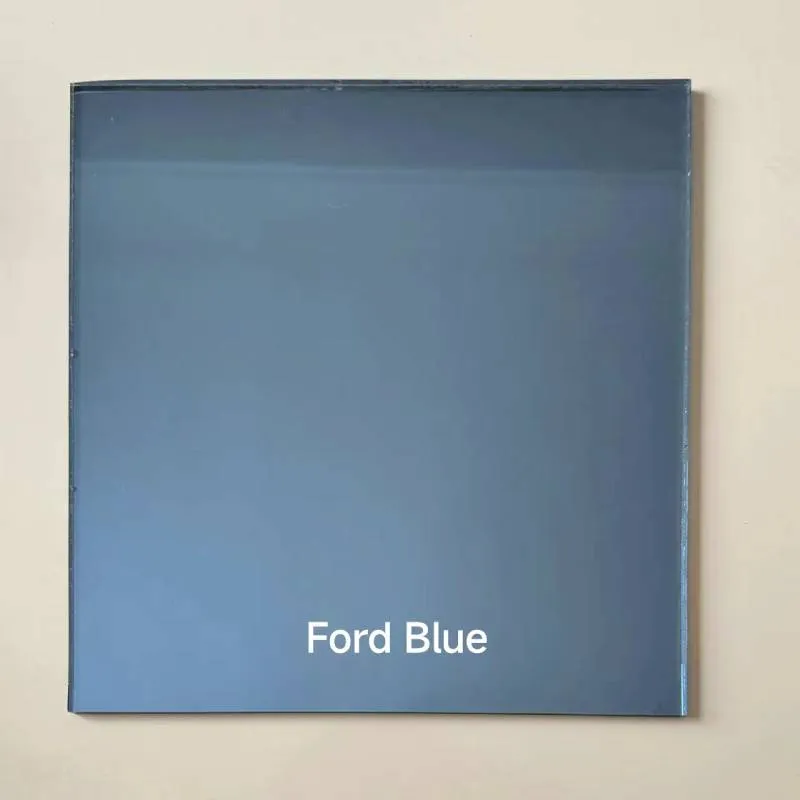

In the world of modern architecture and interior design, tinted glass is more than a design choice—it's a performance-driven solution that enhances both aesthetics and energy efficiency. Whether you're designing high-rise office façades or sun-drenched conservatories, the unique appeal of tinted glass lies in its ability to control solar heat gain while offering a range of elegant hues.

There are several types of tinted glass, each engineered to meet specific functional and visual needs. The most common varieties include bronze, gray, green, and blue tinted glass, each achieved by adding metal oxides to the glass melt during production. These oxides selectively absorb solar radiation, giving the glass its characteristic color and solar performance.
Blue tinted glass, for example, is popular in commercial and marine settings, offering a sleek appearance while minimizing glare. Gray and bronze variants are ideal for residential applications where privacy and thermal comfort are desired. Each type of tinted glass provides a distinct aesthetic, allowing designers to choose glass that complements building exteriors or interior decor themes.
The manufacturing of tinted glass involves the infusion of metal oxides—such as iron, cobalt, or selenium—into the molten glass. This chemical composition alters the way light and heat interact with the glass surface. As a result, tinted glass not only reduces brightness but also filters harmful UV rays and reduces heat penetration.
During production, the raw materials are melted at high temperatures in a float glass furnace. As the glass cools and solidifies on a molten tin bed, the coloration remains embedded in the glass, offering durability and uniformity that coatings or films simply can’t match.
This process ensures that tinted glass for sale retains its color and performance for decades without fading, even under harsh sunlight exposure.
A key performance metric for tinted glass is the shading coefficient—a number that expresses how much solar heat passes through the glass compared to clear glass. The lower the shading coefficient, the better the glass performs at reducing solar gain.
As the light transmittance of tinted glass decreases, its ability to control heat and glare improves. For instance, darker types of tinted glass offer greater solar control, reducing the need for artificial cooling and leading to long-term energy savings. This balance between visibility and thermal protection makes tinted glass a smart investment for both comfort and efficiency.
Developers and designers can fine-tune their glass selection based on building orientation, climate, and energy requirements, making tinted glass for sale a performance-driven design element.
Tinted glass is as functional as it is stylish. In residential settings, it provides privacy and UV protection without the need for curtains or blinds. In commercial architecture, it elevates the facade’s appearance while reducing interior heat buildup.
When used in skylights, partitions, balustrades, or shower enclosures, tinted glass adds a touch of elegance while maintaining practicality. Architects appreciate the flexibility in size, thickness, and color, while property owners value its low-maintenance durability.
With types of tinted glass tailored to meet diverse needs, from subtle green to dramatic charcoal tones, the creative possibilities are endless.
The tinted glass cost depends on several factors, including glass thickness, color intensity, surface treatments, and processing requirements such as tempering or laminating. While it may be slightly more expensive than clear glass, the long-term energy savings, aesthetic impact, and durability make it a cost-effective solution.
Clients seeking high-quality, performance-focused glass can explore options from leading tinted glass for sale suppliers who offer customizable products to meet both residential and commercial demands.
Whether you're designing a luxury resort or modernizing a downtown office building, tinted glass offers tangible value and visual excellence.
Common types of tinted glass include bronze, gray, green, and blue tinted glass, each with unique solar control and design attributes suited for specific architectural applications.
Tinted glass is produced by adding metal oxides to molten glass during the float process. This coloration is infused into the glass, offering long-lasting color stability and solar performance.
By reducing solar transmittance, tinted glass lowers indoor heat gain, improves comfort, and decreases reliance on air conditioning—especially in sun-exposed buildings.
The tinted glass cost is generally higher due to added materials and processing, but its energy savings and visual appeal make it a worthwhile long-term investment.
Yes, many manufacturers offer custom sizing, thickness, and color intensity, allowing tinted glass for sale to be tailored to the specifications of any architectural or design project.